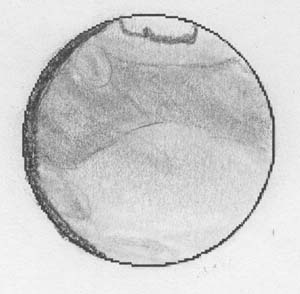
Sketched July 23, 2003 from my back deck 4:00 a.m. pacific DST (daylight standard time) or 11:00 UT. Good observing night from 3:30 a.m. to 4:00 a.m. when the fog started rising. By 4:15 a.m. Mars was blinking in and out of view.
| Date: 07/23/03 Lat 37.6N, Long 122W, elev. 200 feet | Sketch Time (UT): 11:00, (local time): 4:00 a.m. DST |
| Central Meridian: 93° | Filters: #80A light blue, #82A blue, #25 red |
| Instrument: 4-inch (105mm) f/6 Astro-Physics Traveler Apo refractor. | Distance from earth 0.45 AU, 68m km, 42m miles |
| Magnification: (4mm) 376x Zeiss Abbe Ortho combined with a 2.4x AP Barcon Barlow | Transp. 3/6, Seeing 6/10, Antoniadi (I-V): III |
| Apparent Size: 20.8" | Magnitude: -2.1 |
South Polar Cap notch and dark melt line continue to be prominent. Most other features blended into one large dark area, with a few subtle gradients in color. Of these, Agyrre is a ligher feature nearest the South Polar Cap on the terminator. Below it is Pyrrhea Regio, and closer to the north polar region is Chryse, shown a little too dark in my sketch. It is an arrowhead shaped lighter feature. Blue filters 80a and 82a continue to help pick out the lighter features. Solis Lacus, the "eye" of Mars" was almost not visible, only picked up with a red #25 filter. It's the smudge in the center of the image.
Mars, in this sketch is reversed N/S. South is shown at the top of the image. The south polar cap is the prominent feature, and shows a notch that was quite distinct to me. Terminator is where daylight ends and evening begins. The terminator is on the left and the planet is rotating left to right. In my sketches the planet rotates martian east (left) to west (right) to match most other images and sketches. Look for features rotating from left to right in the drawings from night to night.
Details about Mars: Diameter 20.8 arc seconds (Jupiter is about 30 -50 arc seconds in diameter depending on its distance from earth). Central Meridian 93 - the imaginary line passing through the planetary poles of rotation and bisecting the planetary disk, and is used to determine the longitude during an observing session. The martian disk is now larger than last opposition in 2001, and we still have a month until opposition!

White Oaks Home | Sketches Index | Mars 2003 Index | Back | Next